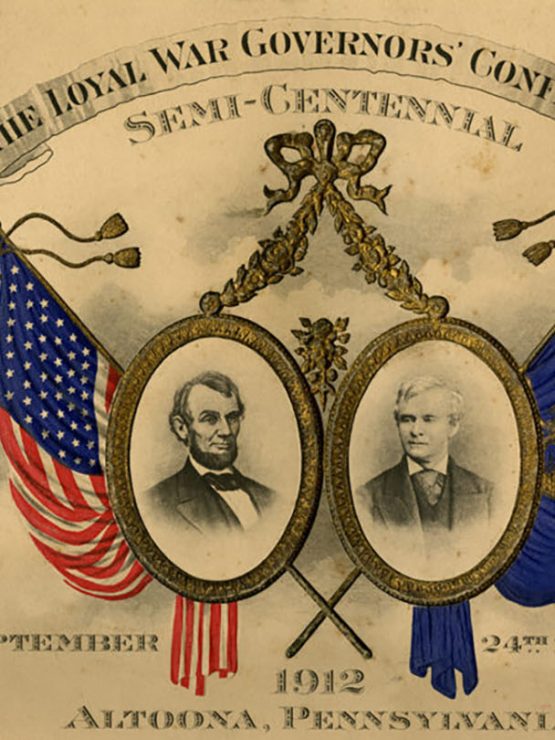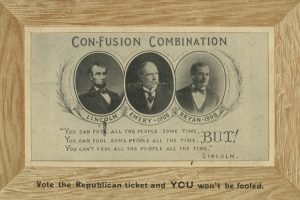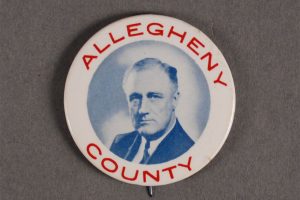
Krasik Collection of Pennsylvania & Presidential Political Memorabilia
The Elaine B. and Carl Krasik Collection of Pennsylvania and Presidential Political Memorabilia contains thousands of pieces of ephemera that documents more than 200 years of state and national politics.
The items range from fabric ribbons to paper election results, sheet music to audio recordings, all created between 1790 and 2014. The materials provide a fascinating connection to the people and issues that defined politics. They track the activities and attitudes of various political parties and government offices, as well as the opinions shared in key debates. Many of the pieces document American cultural history and demonstrate the connection between Pennsylvania and national politics.
Primarily paper-based materials from the collection are housed with the archival collection within the Detre Library & Archives, while three-dimensional objects are stored within the History Center museum collections.
Presidential Campaigns, 1790-2012
This digital exhibit highlights a small sample of the presidential pieces in the Krasik Collection. The items range from 1790 to the presidential election of 2012. Pieces with Pennsylvania connections are highlighted.
The twists and turns of Pennsylvania political and presidential history can be traced through these collection materials. For example, we now call the state’s leader the governor, but Pennsylvania’s first Constitution of 1776 gives the title “president” to the head of the state’s executive branch. By 1790, the U.S. government had replaced the Articles of Confederation with the Constitution, which resulted in a strong federal government and an executive branch headed by a national president. The creation of a new state constitution brought about the birth of the position of governor in Pennsylvania. An etched portrait in the Krasik Collection depicts Pennsylvania’s last president and first governor, Thomas Mifflin.
In another example of the connection between national and state politics, gubernatorial and presidential candidates in the mid-19th century often campaigned in the same year, as the governor’s term lasted only three years. A ribbon for Abraham Lincoln’s 1860 campaign also features future Governor Andrew G. Curtin’s name. Changes made to the state constitution in 1874 established a four-year term for governors with no consecutive terms. This last restriction would be lifted by the passage of the 1968 Constitution.
A campaign poster supporting Herbert Hoover for president and various candidates for Pennsylvania offices also documents changes in the political process. In 1913, the 17th amendment to the Constitution passed, which enabled the people to directly elect senators to Congress instead of the state legislatures that elected them previously. After 1914, presidential and senatorial candidates begin to appear on campaign items together.
Look for items with a Pittsburgh connection, including a program from a 1984 Democratic Presidential debate held at the David L. Lawrence Convention Center and a Franklin Delano Roosevelt campaign button from Allegheny County.
For more detailed information, please see the archival finding aid for The Elaine B. and Carl Krasik Collection of Pennsylvania and Presidential Political Memorabilia, MSS 1068, or contact museum collections staff.
Collection Highlights





Further Research
“James Addams Beaver.” Pennsylvania Historical & Museum Commission. Accessed 9/17/2016.
“‘Get Out the Vote:’ Campaigning for the U.S. Presidency.” Division of Rare & Manuscript Collections, Cornell University.
Pittsburgh Gazette.
“Lincoln Penny.” United States Mint. Accessed A8/30/16.
Pennsylvania’s Constitutions, Duquesne University.
“James A. Garfield: Campaigns and Elections.” The Miller Center. Accessed 8/30/16.
22nd Amendment. ConstitutionCenter.org.
Snyder, Charles McCool. The Jacksonian Heritage Pennsylvania Politics, 1833-1848. Harrisburg: The Pennsylvania Historical and Museum Commission, 1958.